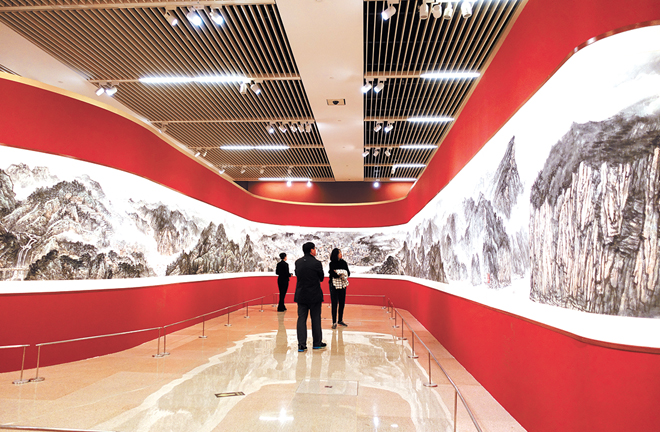Yangtze River Basin and rise of civilization

Visitors appreciate the painting 10,000 Miles along the Yangtze River created by many Chinese artists at National Museum of China. Photo: CFP
A host of archaeological findings indicate that from 4,000 to 6,000 years ago, representative prehistoric cultures were cradled along the Yellow River Basin, Liaohe River Basin and the middle and lower reaches of the Yangtze River Basin, such as the Longshan, Hongshan, Liangzhu and Shijiahe cultures. Despite their diverse characteristics, these cultures once developed parallel to each other and kept pace. But in the critical march toward a civilized society, the Yellow River Basin stood alone. What was the historical and cultural logic behind this situation? A CSST reporter interviewed Qiu Shijing, a professor from the School of History and Society at Anhui Normal University.
CSST: What are your views on the prehistoric culture of the Yangtze River Basin and the Yellow River Basin?
Qiu Shijing: Archaeological data gives evidence that the cultural development of the Yangtze River basin in the Neolithic Age, especially in the Yangtze River Delta, did not lag behind that of the Yellow River Basin. In 1982, based on archaeological research, I proposed that the middle and lower reaches of the Yellow River and the Yangtze River were the earliest two economic centers in China, and they were two cultural systems advancing in parallel. The ancestors living in these two regions created distinctive cultures through hard work. At the same time, the middle and late stages of the Longshan and Liangzhu cultures had entered the heyday of the paternal clan commune, welcoming the eve of the class society, the primary stage of a state.
At the turning point of history, however, the middle and lower reaches of the Yellow River leaped forward as the first to leave the clan system and enter the class society, thus becoming the central area of the (Xia), Shang and Zhou civilizations. The development of civilization in the Yangtze River Basin was slower. During the Spring and Autumn Period and the Warring States Period, the southern region witnessed the prosperity of the Wu, Yue and Chu kingdoms which ultimately obeyed the Central Plains culture. Until the Han Dynasty, people in the vast areas of the Jiangnan region relied heavily on fishing, hunting and forestry. The 400 years of great effort after the Six Dynasties pushed the region to catch up with the Yellow River Basin in terms of economy in the Tang and Song dynasties, later to surpass it in all respects in the Ming and Qing dynasties. The trend of the Yangtze being the backbone of China’s economy and culture has continued into modern times.
CSST: Compared to the Yellow River Basin, what difficulties and problems were encountered in the development of primitive agriculture in the Yangtze River Basin?
Qiu Shijing: Rice cultivation in the Yangtze River Basin was common in some places; rice had become one of the ancestors’ food sources in this region. However, multiple pieces of evidence indicate that the further development of primitive agriculture to the south of the Yangtze River encountered many obstacles as its advantages in geographical and natural conditions failed to be fully realized. It was difficult to form a comprehensive economic pattern dominated by agriculture. For a long period, fishing and hunting accounted for a large proportion of economic life. Therefore, the lack of surplus products and the sluggish development of private ownership led to slow social development.
Regarding geographical conditions, there were narrow and long plains in the south of the Yangtze River dotted by mountains, hills and dense forests. Paddy field agriculture was carried out in swamps and relatively low-lying areas, where the soil was fertile and conducive to reclamation, but it took massive labor to transform this land into a field suitable for rice growth. In the Tang and Song dynasties, the time and labor required for planting rice were more than three times that of growing food in dry soil. The expansion of paddy agriculture was constrained by natural conditions, which inevitably affected rice yield, and thus entered the development of primitive agriculture. After the Han Dynasty, widespread iron farming equipment and cattle farming technology as well as renovated water conservancy facilities guaranteed rice production and empowered development in the southern region.
CSST: Different from the economy dominated by agriculture in the Central Plain, fishing, hunting and forestry supported the economy to the south of the Yangtze River. Why was it like this?
Qiu Shijing: Jiangnan was vast and sparsely populated. Its small population basis and damp weather were a boon for the spread of disease. Rich natural resources created conditions for the existence and continued development of the fishing and hunting economy. The ancestors, without hard work, could get sufficient food and daily necessities by fishing and hunting. The easy access to living materials and the unique natural conditions weakened the practical need to further develop into agriculture and animal husbandry, which to a great deal held back the pace of development. Also, rice plantation demands greater time and effort. Therefore, although agriculture to the south of the Yangtze River was developing, it was not able to develop an economic system dominated by agriculture.
About 4,000 to 5,000 years ago, the struggle among such groups as the Huaxia, Dongyi and Miaoman instigated a large-scale integration among ethnic groups in the formation and development of the Chinese nation. Ultimately, a center formed around the Huaxia group in the Yellow River Basin. This kind of integration remarkably promoted the progress of the Central Plain. Also, it restricted the defeated tribes and affected the development of local indigenous cultures. There has been regression or stagnation in some places, causing or augmenting the imbalance of social development.
edited by MA YUHONG
